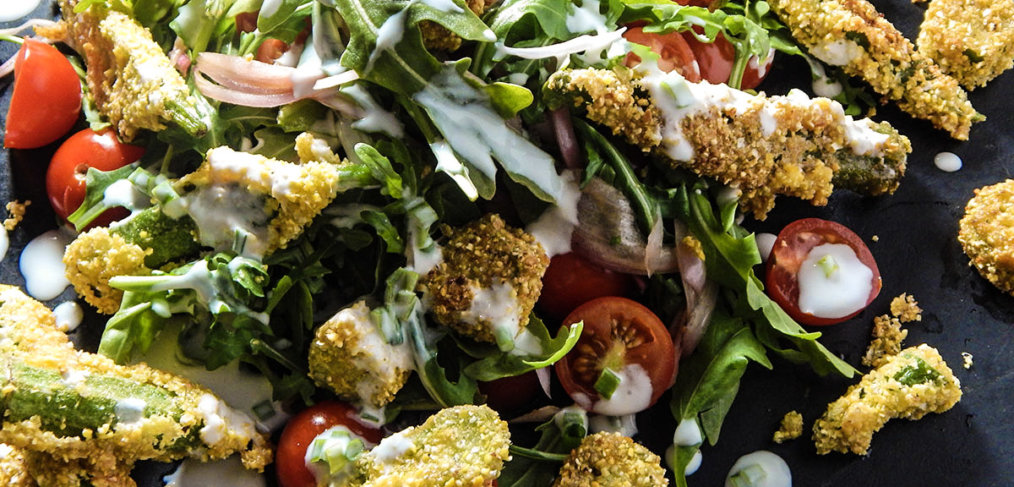
Fried Okra & Tomato Salad
Makes 4 Servings
Fried Okra is probably one of my personal favorite Southern traditions. Crunchy and flavorful, these little bites always bring joy to a summer dinner. These little beauties were a transplant to the Americas from Africa during the prime of the slave trade. The traders wanted to keep the slaves from being too homesick, so they brought along several foods such as rice and okra overseas. The okra made its way to Brazil and the Caribbean.
Okra is thought to have originated in the Abyssinian region, which includes modern-day Ethiopia, and in the 12 C B.C., there is evidence of okra cultivation in Egypt. The pods were used to eat and the seeds were dried and ground and used like coffee. It grows the best in a tropical climate, which I am sure is why the plant thrives in the U.S. South, which is considered sub-tropical. The plant is also part of the cotton and hibiscus plants. The okra flower favors a hibiscus’ beauty as well.
In the Niger-Congo region, the Twi Language called the pods “Nkrumah”. As discussed in the last posts, the Portuguese were traders in Africa called the plant “Gombo”, which was a corruption of quingombo or quillobo that was also a name for the okra plant in Congo and Angola. Today, you can find wild okra growing in Ethiopia and around the Nile.
By 1658, okra reached Brazil and was known to be eaten in Suriname by 1689. It is thought to have come to the Louisiana region in the 1700s. Gumbo, which I am not doing a recipe on, because I am creating it for a cookbook coming out in the Fall, was actually a combination of both the African culture using the okra to thicken stews and soups and the Native Americans utilizing sassafras in their soups. Louisiana French background added in the roux, while Charleston style gumbos just use the okra to thicken the soup.
Fried okra is a Soul Food or Comfort Food in the South. I had a hard time getting detailed information on how this tradition was passed down. The reason for the difficulty probably stems from the fact that slaves weren’t allowed to read or write, so their recipes and traditions were passed down by word of mouth and the fact that the white Americans would take the recipes from their slaves or their hired help (post-Emancipation) and recorded them as their own.
Slaves were given rations during the weeks to eat. Rice was a staple as was okra and corn. It was inexpensive and after reading one article meats were not given often to the slaves because the slave owners believed the meat would cause them to be more lethargic after eating and becoming less productive (the science behind this is so wrong, but I can’t imagine people thinking it was okay to enslave people to understand basic nutrition principals). The high calories were necessary in order to withstand long, hot days working, which was why deep-frying, breading in cornmeal, cornbread, and other dishes were created.
So, check out my fried okra recipe. I combined the fried okra into a salad with tomatoes (as a play on the traditional dish stewed tomatoes and okra (also an African one-pot meal concoction) and to create something a little lighter in this steaming heat in Alabama presently.
Avocado or palm oil
1 pound okra, sliced lengthwise or in rounds
1 large egg
3 tablespoons heavy whipping cream
¾ cup fine yellow cornmeal
1 ½ cups cherry tomatoes, halved
3 cups arugula
½ cup pickled shallots, recipe follows
1/3 cup whole plain Greek yogurt
3 tablespoons fresh lemon juice
3 tablespoons water
2 tablespoons fresh chopped chives
¼ teaspoon sea salt, plus more for sprinkling on okra
¼ teaspoon ground black pepper
In a cast-iron skillet add oil about ½-inch deep into the pan. Heat over medium heat until oil begins to sizzle when a small droplet of cornmeal is placed in the pan.
While oil is heating, in a medium bowl whisk together egg and heavy cream until combined. In another bowl, add cornmeal. Dredge the okra first in the egg mixture and then into the cornmeal. Place gently, being careful not to overcrowd the pan; cooking about 2 -3 minutes per side until golden brown, using a slotted spoon, metal spatula or fork to turn over. Remove from pan and place on a cooling rack placed over a sheet pan, sprinkle with sea salt as desired. Repeat with remaining okra.
In a small bowl, whisk together yogurt, lemon juice, water, chives, salt, and pepper until combined.
In a large bowl, combine arugula, tomatoes, shallots, and okra. Divide between 4 plates and drizzle yogurt over salad. Serve immediately.
